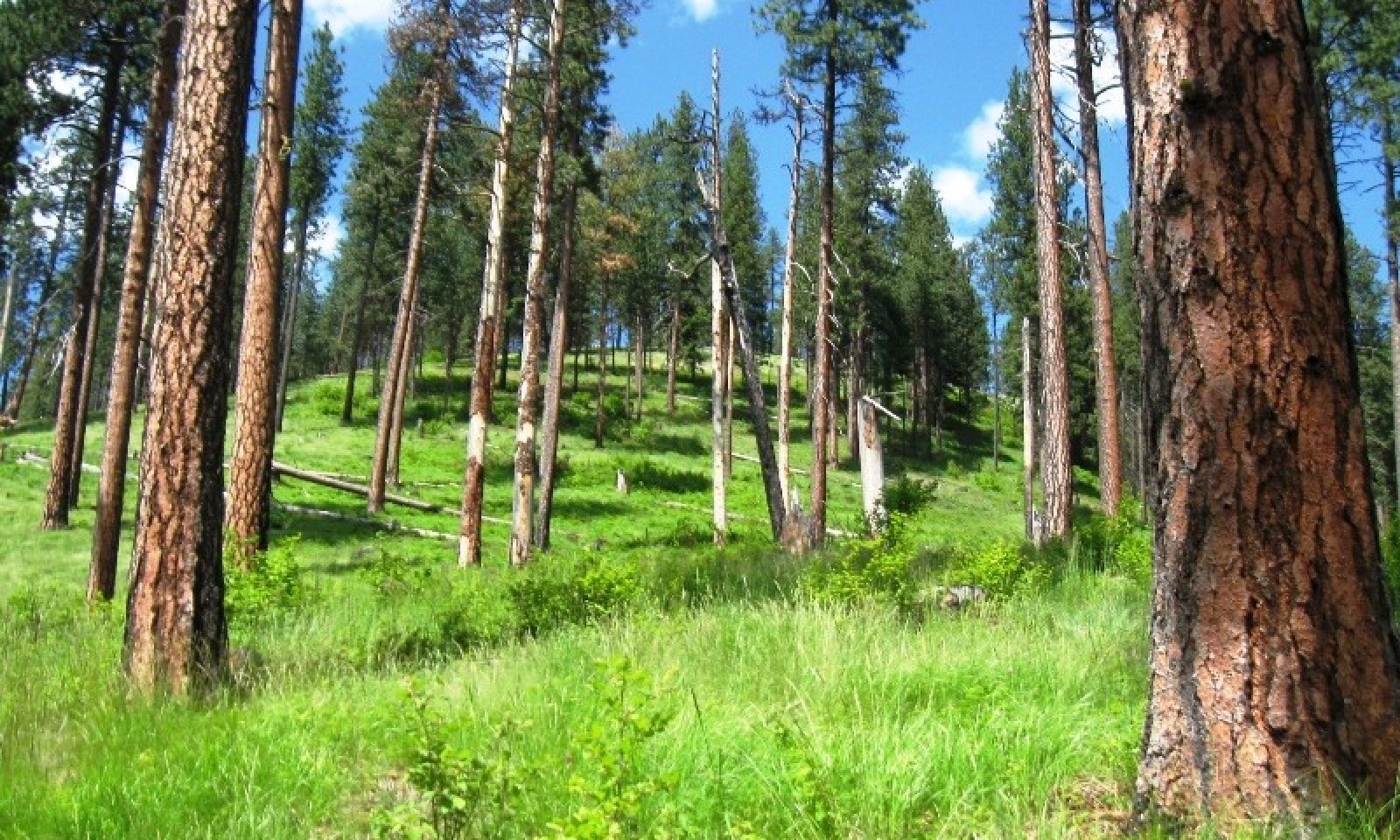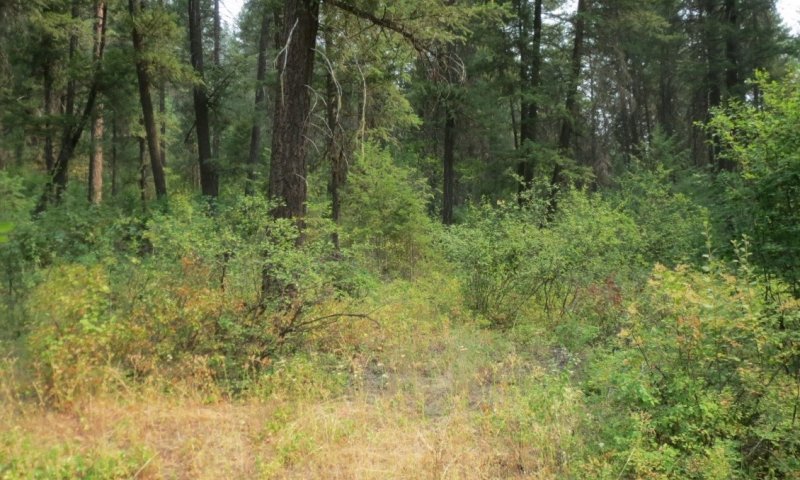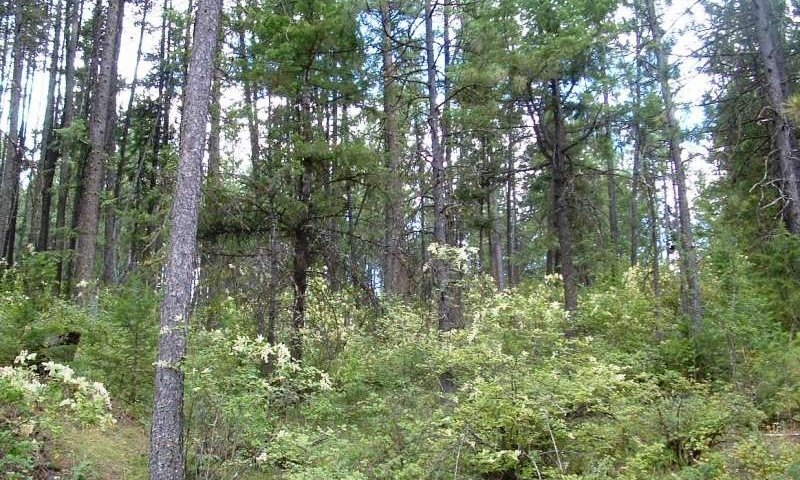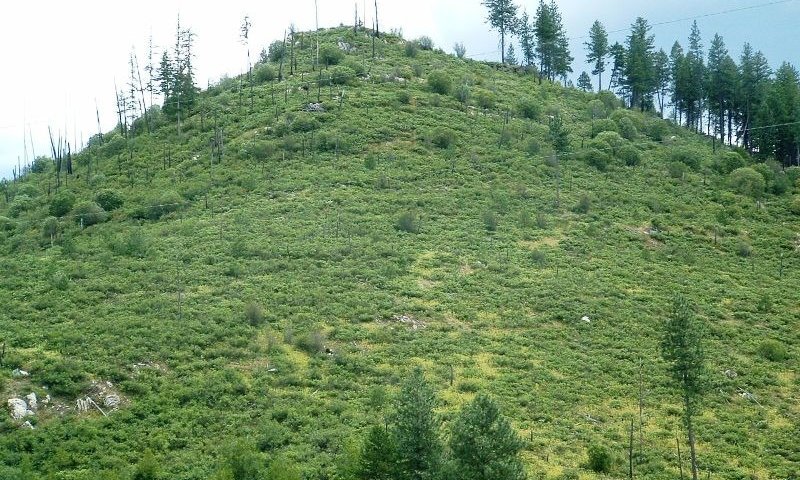
Ecological site group EX043AESG05
Warm-Frigid, Xeric Hill and Mountain Slopes (Douglas-Fir Warm Dry Shrub) Pseudotsuga menziesii / Physocarpus malvaceus - Symphoricarpos albus
Last updated: 05/02/2025
Accessed: 12/19/2025
Ecological site group description
Key Characteristics
None specified
Provisional. A provisional ecological site description has undergone quality control and quality assurance review. It contains a working state and transition model and enough information to identify the ecological site.
Physiography
Major Land Resource Area: 43A Northern Rocky Mountains and Foothills
Modal LRU – 43A03 - Columbia-Colville Valleys
This LRU is composed predominantly of low elevation valley floors and the slopes of foothills or low mountains adjacent to the Columbia and Colville rivers. The soils tend to be loamy mollisols and inceptisols with mixed or thin ash surfaces. Till and outwash are the dominant parent materials. Soil climate is a mesic or frigid temperature regime and xeric moisture regime with average annual precipitation around 495 mm (19 inches).
Others where occurring – 43A01 - Okanogan Plateau
43A02 - Western Selkirk Highlands
43A04 - Selkirk Mountains
Ecological Site Concept:
The data below describes the physiographic, climatic and other parameters for the Douglas-fir/warm, dry shrub ES group as a whole. This vegetation alliance is widespread so a central tendency for each parameter is also described. See Appendix A for a finer division of the alliance based on selected soil features.
This ESD in distinguished by an overstory of ponderosa pine and Douglas-fir and an understory shrub component of ninebark, oceanspray, and snowberry. It occurs on foothills, mountainsides, and flat terraces. Pre European frequent low intensity fire created open ponderosa stands with grass/herbaceous understory, mainly pinegrass. With fire suppression and management use stands currently have high density with multiple overstories of ponderosa pine and Douglas-fir. With infrequent fire shrubs will dominate the understory. This ESD fits into the National Vegetation Standard’s Central Rocky Mt. Ponderosa Pine – Douglas-fir Dry shrub alliance and Washington State’s Natural Heritage Program’s Northern Rocky Mt. Dry Mesic Montane Mixed Conifer Forest.
Physiographic Features
This ecological site group occurs mainly on low to mid elevation slopes of glaciated mountains and foothills. It is found predominantly on sideslopes and foot slopes. The parent material is volcanic ash or mixed volcanic ash and loess over till, loamy outwash or residuum and colluvium from mainly granitic and metasedimentary rock.
Landscapes: Mountains, Foothills, Valleys
Landform: Mountain slope, Hill slope, Outwash Terraces
Elevation:
Total range = 290 to 1585 m
(950 to 5,200 feet)
Central tendency = 705 to 1150 m
(2,300 to 3,770 feet)
Slope (percent):
Total range = 0 to 80 percent
Central tendency = 8 to 45 percent
Water Table Depth:
60 cm to >200 cm
(24 to >80 inches)
Flooding:
Frequency:
None
Duration:
None
Ponding:
Frequency:
None
Duration:
None
Runoff Class:
Low to Very high
Aspect:
290-30-160 in 43A01, 43A02, 43A03
115-240-318 in 43A04
Appendix A
Examination of map unit components assigned to the Douglas-fir/shrub alliance showed three possible subdivisions of the larger ecological group.
These are:
1) Warm Frigid Xeric Loamy Foothills/Mountainsides, ashy surface (Douglas-Fir Warm Dry Shrub)
2) Warm Frigid Xeric Loamy Foothills/Mountainsides, mixed ash surface (Douglas-Fir Warm Dry Shrub)
3) Warm Frigid Xeric Loamy Foothills/Mountainsides, low AWC subsoils (Douglas-Fir Warm Dry Shrub)
A.1 Warm Frigid Xeric Ashy Slopes, ashy surface (Douglas-Fir Warm Dry Shrub)
Most commonly found in LRU 43A02 (Western Selkirk Mountains). Also found in adjacent areas of 43A01 and 43A03. Climate parameters were obtained from PRISM and other models for the area. Landscape descriptors are derived from USGS DEM products and their derivatives.
Physiographic Features
Landscapes: Mountains, Foothills
Landform: sideslopes, foot slopes, lake terraces, outwash terraces
Elevation (m): Total range = 395 to 1680 m
(1,290 to 5,510 feet)
Central tendency = 875 to 1195 m
(2,870 to 3,920 feet)
Slope (percent): Total range = 0 to 85 percent
Central tendency = 15 to 45 percent
Water Table Depth (cm):
66 cm to >200 cm (median = >200cm)
(26 to >80 inches; median = >80 inches)
Flooding:
Frequency: None
Duration: None
Ponding:
Frequency: None
Duration: None
Aspect:
290-30-160
Climatic Features
Frost-free period (days): Total range = 75 to 130 days
Central tendency = 95 to 110 days
Mean annual precipitation (cm): Total range = 265 to 985 mm
(10 to 39 inches)
Central tendency = 445 to 665 mm
(17 to 26 inches)
MAAT (C): Total range = 3.3 to 9.8
(38 to 50 F)
Central tendency = 5.7 to 7.3
(42 to 45 F)
Climate Stations: Boundary Dam, Chewelah
Representative Soil Features
This ecological subsite is associated with several soil series (e.g. Inkler, Nevine, Oxerine, Scrabblers and Eloika). The soil components can be grouped into: Typic Vitrixerands, and Andic Haploxerepts. These soils have developed in Mazama tephra deposits over till, glaciolacustrine material, outwash and residuum and colluvium from granitic and metasedimentary rock. The tephra layers are important for forest productivity in that they retain large amounts of water compared to other parent materials, have high cation exchange capacity and high availability of organically bound plant nutrients. The soils range from moderately deep to very deep and have adequate available water capacity to a depth of 1 m. The soils are mostly well-drained.
Parent Materials:
Kind: Tephra (volcanic ash)
Origin: mixed
Kind: till, residuum and colluvium, outwash and
glaciolacustrine material
Origin: Granite, Metasedimentary rock
Surface Texture:
(1)Ashy Fine sandy loam
(2)Ashy Silt loam
(3)Ashy Loam
Fragment content of surface: 0 to 16 percent (median = 0%)
Subsurface Texture Group: Loamy
Fragment content of subsurface (25 to 100cm): 0 to 60 percent (median = 38%)
Most components lack surface fragments
Drainage Class: Well drained (2% Moderately Well drained components)
Saturated Hydraulic conductivity: Moderately high to High
Soil Depth: 96% of components have no restriction within 150 cm
Lithic contacts when present are at 60 to 145cm (median = 75cm)
Paralithic contacts when present are at 65 to 115cm (median = 65 cm)
Densic contacts when present are at 50 to 180cm (median = 95 cm)
Calcium Carbonate Equivalent (percent): 0
Soil Reaction (1:1 Water): 6.1 to 7.3
Available Water Capacity (total in 100cm): 8.15-19.88cm (median = 11.98cm)
A.2 Warm Frigid Xeric Ashy Slopes, mixed ash surface (Douglas-Fir Warm Dry Shrub)
Most commonly found in LRU 43A03 (Columbia-Colville Valleys). Also found in adjacent areas of 43A01, 43A02 and 44A01. Climate parameters were obtained from PRISM and other models for the area. Landscape descriptors are derived from USGS DEM products and their derivatives.
Physiographic Features
Landscapes: Foothills, Valleys, Mountains
Landform: sideslopes, foot slopes, lake terraces, outwash terraces
Elevation (m): Total range = 290 to 1510 m
(950 to 4,950 feet)
Central tendency = 635 to 985 m
(2,080 to 3,230 feet)
Slope (percent): Total range = 0 to 75 percent
Central tendency = 6 to 35 percent
Water Table Depth (cm): 75 cm to >200 cm (median = >200cm)
(30 to >80 inches; median = >80 inches)
Flooding:
Frequency: None
Duration: None
Ponding:
Frequency: None
Duration: None
Aspect:
290-30-160
Climatic Features
Frost-free period (days): Total range = 80 to 135 days
Central tendency = 105 to 125 days
Mean annual precipitation (cm): Total range = 265 to 940 mm
(10 to 37 inches)
Central tendency = 430 to 635 mm
(17 to 25 inches)
MAAT (C Total range = 4.1 to 11.0
(39 to 52 F)
Central tendency = 6.7 to 8.4
(44 to 47 F)
Climate Stations: Nespelem, Stockdill Ranch
Representative Soil Features
This ecological subsite is associated with several soil series (e.g. Kaniksu, Stapaloop, Kootenai, Torboy, Spokane, Republic, Scoap, Garrison, Cedonia, Wishbone). The soil components can be grouped into: Vitrandic Haploxerolls, Vitrandic Haploxerepts, Vitrandic Haploxeralfs, Lamellic Haploxeralfs, and Vitrandic Palexeralfs. These soils have developed in mixed Mazama tephra, loess and other deposits over till, outwash, residuum and colluvium from granitic and metasedimentary rock, and glaciolacustrine material. The soils range from moderately deep to very deep and have adequate available water capacity to a depth of 1 m. The soils are mostly well-drained (~90% by area).
Parent Materials:
Kind: Tephra (volcanic ash) mixed with loess and other
material
Origin: mixed
Kind: till, residuum and colluvium, outwash and alluvium,
and glaciolacustrine material
Origin: Granite, Metasedimentary rock
Surface Texture:
(1)Ashy Loam
(2)Ashy Silt loam
(3)Ashy Sandy loam
(4)Ashy Fine sandy loam
Fragment content of surface: 0 to 34 percent (median = 10%)
Subsurface Texture Group: Loamy
Fragment content of subsurface (25 to 100cm): 0 to 45 percent (median = 24%)
Most components lack surface fragments
Drainage Class: Well drained (small areas of Moderately Well drained and Somewhat Excessively drained components)
Saturated Hydraulic conductivity: Moderately high to High
Soil Depth: 84% of components have no restriction within 150 cm
Lithic contacts when present are at 50 to 115cm (median = 62cm)
Paralithic contacts when present are at 65 to 145cm (median = 80 cm)
Densic contacts when present are at 80 to 125cm (median = 102 cm)
Calcium Carbonate Equivalent (percent): 0 to 15 percent (median = 0%)
Soil Reaction (1:1 Water): 6.1 to 8.4
Available Water Capacity (total in 100cm): 7.51-20.88cm (median = 12.83cm)
A.3 Warm Frigid Xeric Ashy Slopes, low AWC subsoils (Douglas-Fir Warm Dry Shrub)
Most commonly found in LRU 43A03 (Columbia-Colville Valleys). Also found in adjacent areas of 43A01, 43A02, 43A04 and 44A02. Climate parameters were obtained from PRISM and other models for the area. Landscape descriptors are derived from USGS DEM products and their derivatives.
Physiographic Features
Landscapes: Foothills, Mountains
Landform: sideslopes, summits
Elevation (m): Total range = 390 to 1495 m
(1,280 to 4,900 feet)
Central tendency = 725 to 1035 m
(2,380 to 3,390 feet)
Slope (percent): Total range = 0 to 90 percent
Central tendency = 20 to 45 percent
Water Table Depth (cm): >200 cm
Flooding:
Frequency: None
Duration: None
Ponding:
Frequency: None
Duration: None
Aspect:
68-180-293
Climatic Features
Frost-free period (days): Total range = 105 to 140 days
Central tendency = 105 to 115 days
Mean annual precipitation (cm): Total range = 265 to 1160 mm
(10 to 47 inches)
Central tendency = 490 to 760 mm
(19 to 30 inches)
MAAT (C): Total range = 4.3 to 10.2
(40 to 50 F)
Central tendency = 6.5 to 8.0
(44 to 46 F)
Climate Stations: Newport
Representative Soil Features
This ecological subsite is associated with several soil series (e.g. Treble, Thout, Oxerine, Raisio, and Mineral). The soil components can be grouped into: Vitrandic Haploxerolls, Vitrandic Haploxerepts, Vitrandic Dystroxerepts and Andic Haploxerepts. These soils have developed in mixed Mazama tephra, loess and other deposits over till, and/or residuum and colluvium from granitic and metasedimentary rock. The soils range from moderately deep to very deep and have low available water capacity to a depth of 1 m. The soils are mostly well-drained (~90% by area).
Parent Materials:
Kind: Tephra (volcanic ash) mixed with loess and other
material
Origin: mixed
Kind: residuum and colluvium, and/or till
Origin: Granite, Metasedimentary rock
Surface Texture:
(1)Ashy Sandy loam
(2)Ashy Silt loam
(3)Ashy Very fine sandy loam
Fragment content of surface: 22 to 61 percent (median = 27%)
Subsurface Texture Group: Loamy
Fragment content of subsurface (25 to 100cm): 38 to 80 percent (median = 55%)
Surafce Fragments: about 10% of components have a stony or bouldery surface
Drainage Class: Well drained
Saturated Hydraulic conductivity: Moderately high to High
Soil Depth: ~35% of components have no restriction within 150 cm
Lithic contacts when present are at 25 to 90cm (median = 60cm)
Paralithic contacts when present are at 40 to 65cm (median = 53 cm)
Densic contacts when present are at 40 to 65cm (median = 53 cm)
Calcium Carbonate Equivalent (percent): 0
Soil Reaction (1:1 Water): 6.1 to 7.8
Available Water Capacity (total in 100cm): 5.68-7.64cm (median = 6.24cm)
Climate
Climatic Features
During the spring and summer, a circulation of air around a high-pressure center brings a prevailing westerly and northwesterly flow of comparatively dry, cool and stable air into the region. As the air moves inland, it becomes warmer and drier which results in a dry season beginning in the late spring and reaching a peak in mid-summer. In the fall and winter, a circulation of air around two pressure centers over the ocean brings a prevailing southwesterly and westerly flow of air into the Pacific Northwest. This air from over the ocean is moist and near the temperature of the water. Condensation occurs as the air moves inland over the cooler land and rises along the windward slopes of the mountains or highlands. This results in a wet season beginning in October, reaching a peak in winter, then gradually decreasing in the spring.
The elevation within the LRU varies from approximately 1,000 feet in the lower river valleys to 3,400 feet over the higher terrain. The annual precipitation increases from 18 inches in the valley to 24 inches over the higher foothills. Winter season snowfall varies from 30 to 50 inches. Both rainfall and snowfall increase in the higher elevations. Snow can be expected after the first of November and to remain on the ground from the first of December until March or April.
In January, the average maximum temperature is near 31° F and the minimum temperature is 18° F. Minimum temperatures from -10° to -20°F are recorded almost every winter and temperatures ranging to -30° F have been recorded. In July, the average maximum temperature is 85° to 90° and the minimum temperature 45° to 50° F. Maximum temperatures reach 100° F on a few afternoons each summer and temperatures between 105° to 110° F have been recorded. Temperatures in the mountains decrease three to five degrees Fahrenheit with each 1,000 feet increase in elevation. The average date of the last freezing temperatures can be expected by mid-May and before mid-October in the warmer areas.
(Compiled from WRCC: Climate of Washington and available station data)
Frost-free period (days):
Total range = 80 to 130 days
Central tendency = 100 to 120 days
Mean annual precipitation (cm):
Total range = 265 to 985 mm
(10 to 39 inches)
Central tendency = 410 to 700 mm
(16 to 28 inches)
MAAT (C)
Total range = 3.8 to 10.3
(39 to 51 F)
Central tendency = 6.0 to 8.1
(43 to 47 F)
Climate Stations:
Boundary Dam, Chewelah, Nespelem, Stockdill Ranch, Newport
Soil features
Representative Soil Features
This ecological site group is associated with several soil components. The soil components can be grouped into four soil subgroups: Typic Vitrixerands, Vitrandic Haploxerepts, Vitrandic Dystroxerepts, Vitrandic Haploxerolls, and Andic Haploxerepts. Most of these soils have developed in Mazama tephra deposits over till, outwash and residuum and colluvium from granitic and metasedimentary rock. These tephra layers are important for forest productivity in that they retain large amounts of water compared to other parent materials, have high cation exchange capacity and high availability of organically bound plant nutrients. Minor amounts of soil are formed in lacustrine deposits. The soils range from shallow (lithic bedrock) to very deep. Many of these soils have dense till layers at a depth of 20 to 40 inches and have a low available water holding capacity and slow to very slow permeability in the till layers. The soils are mostly moderately well drained to well-drained. Surface textures include ashy fine sandy loam, gravelly ashy sandy loam, stony and/or very stony ashy sandy loam. See appendix A for a discussion of different sundivisions of the Douglas-fir/shrub alliance based on differences in soils features.
Parent Materials:
Kind: Tephra (volcanic ash)
Origin: mixed
Kind: residuum and colluvium
Origin: Granite, Metasedimentary rock
Surface Texture:
(1)Ashy Fine sandy loam
(2) Sandy loam
Subsurface Texture Group: Loamy
Drainage Class: Moderately well drained To Somewhat excessively drained
Permeability Class: Impermeable To Moderately rapid
Vegetation dynamics
Ecological Dynamics of the Site
The reference state occurred before European settlement when frequent low intensity fires created open stands of large ponderosa pine with a grass dominated understory of pinegrass. Patches of Douglas-fir regeneration will be present. On the lower foothills this ecological site occurs on north and east slopes. On upper mountainous terrain it will occur on southern and western aspects. The model soil characteristics will be loamy over till or mixed colluvium. Sites escaping frequent fire will have a patchy mosaic of older large trees with patches of regeneration, pole stands of ponderosa pine and Douglas-fir, and a mixture of shrubs, grasses and forbs. Bark beetle and root disease mortality will create snags and woody debris. Severe stand replacing fires can result in ceanothus shrub fields dominating for several years until natural regeneration of pine and Douglas-fir reclaim the site. In other less severe burned areas, grass and sedge species will dominate along with sprouting shrubs like ninebark, oceanspray, and snowberry. This ecological site is similar to the Douglas-fir – Ponderosa pine – Western Larch / pinegrass ecological site (Douglas-fir Cool Dry Grass), however the presence of western larch is rare on the model site. This site being warmer and not adequate for larch growth. The Douglas-fir Cool Dry Grass ecological site climate is cooler located at higher elevations allowing western larch to become a prominent stand component in mature stands.
Lack of fire or fire exclusion crosses a threshold and the site goes to another state. State 2 results in homogenous multi-storied stands of ponderosa pine and Douglas-fir with dense understories of regeneration and/or shrubs. Snags and wood debris are lacking. These stands are highly susceptible to stand replacing fires. Much of the acreage of this ecological site is in this condition. Timber stand improvement and fuel removal treatments along with prescribed fire can restore this site to a more open patchy landscape more resistant to severe fire.
In Alternative State 3 severe fire has damaged soil nutrient capacity with shrub fields of ceanothus species dominating the site for 50+ years. This condition more commonly occurring on south and west facing slopes. Restoration activities must be scrutinized on a site by site basis.
In Alternative State 4 some of the lower landscape portions of this ecological site have been converted to introduced grass pastures or annual cropland. Restoring this site to the reference state takes major inputs in site preparation, tree planting, vegetation control, fuels management and other silvicultural treatments.
Major Land Resource Area
MLRA 043A
Northern Rocky Mountains
Subclasses
- F043AY517WA–Warm-Frigid, Xeric, Loamy Foothills/Mountainsides, ashy surface (Douglas-Fir/Warm Dry Shrub) Pseudotsuga menziesii / Physocarpus malvaceus - Symphoricarpos albus
- F043AY518WA–Warm-Frigid, Xeric, Loamy Slopes, mixed ash surface (Douglas-Fir/Warm Dry Shrub) Pseudotsuga menziesii / Physocarpus malvaceus - Symphoricarpos albus
- F043AY519WA–Warm-Frigid, Xeric, Loamy Slopes, low AWC subsoils (Douglas-Fir/Warm Dry Shrub) Pseudotsuga menziesii / Physocarpus malvaceus - Symphoricarpos albus
- F043AY585WA–Warm-Frigid, Xeric, Sandy, Outwash Terraces (Douglas-fir Warm Dry Shrub)
Stage
Provisional
Click on box and path labels to scroll to the respective text.



